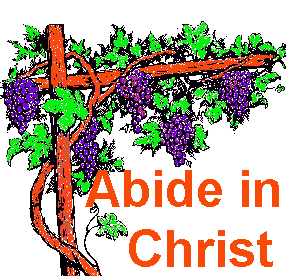The Lion and the Lamb
Revelation belongs to a
class of biblical writings known as apocalyptic. It
is the only one of its kind in the New Testament.
Daniel, Ezekiel and Zechariah are apocalyptic
writings in the Old Testament. This type of
literature has the following characteristics:
(1) There is an extensive
use of symbols and visions.
(2) God's people are
portrayed as suffering unjustly.
(3) It's contents
includes future events.
(4) God is always seen
saving His people at the end of time.
AUTHOR:
The writer gives his name as John (1:1, 4, 9; 22:8).
We believe this John to be the same one who wrote
the Gospel and the three Epistles. Tradition
identifies him as John the Apostle, the son of
Zebedee. Justin Martyr, a disciple of Polycarp,
wrote about A.D. 140-160 that John the Apostle was
the author of Revelation. This is strong early
testimony for the authorship since Polycarp was
himself a disciple of John. Justin's information
came from the man who knew the facts personally. It
appears that the second century tradition
unanimously favored John the Apostle as the author.
Some of the grammatical and syntactical differences
between Revelation and the other books attributed to
John can be explained by the fact that John was
living under unusual circumstances in exile on the
island of Patmos. There was no one there to help
John polish and smooth his Greek grammar. It was an
urgent message that John had to communicate to the
churches in Asia Minor who were undergoing
persecution for their faith. Apparently, John wrote
as the visions appeared to him, and without delay.
On the other hand, the Gospel and epistles were
written in a time when John had more leisure and
with possible help of a secretary. Far less
convincing is the hypothesis that another John,
called "the elder," wrote these books.
DATE:
Clearly from the contents of the book this is a time
when Christians were being severely persecuted by
the Roman government. Believers were being pressured
to recant their faith and believe in the cult of
emperor worship. The only date that fits all of the
conditions during the time of Revelation is A.D. 95
or 96. It was a time of great persecution for
Christians. They were being crucified, burned alive
as torches, thrown to lions, and forced to kill one
another as gladiators. There were three cycles of
persecution during the second half of the first
century. Nero's was the first, in the middle
sixties. Domitian's was the second, between A.D. 84
and 96, and Trajan's was the last, in the late
nineties. The Roman emperor, Domitian (A.D. 81-96),
had claimed divinity and demanded that his subjects
worship him. When the Christians refused, they were
accused of disloyalty to the state. Many were
tortured and slain. Others were imprisoned. Many had
their faith severely tested. Earlier dates, i.e.
A.D. 67-68 during Nero's reign, do not provide the
kind of background reflected in this book. Moreover,
all attempts to show that John the Apostle died
earlier than A.D. 96 have failed.
PLACE OF WRITING:
John was being held prisoner on the island of
Patmos, 35 miles off the coast of Asia Minor when he
received these visions of the resurrected and
exalted Christ (1:9).
RECIPIENTS:
The first readers of Revelation were the "seven
churches of Asia" (1:4). Thirty years earlier these
were vibrant healthy churches that had received
letters from Peter and Paul.
PURPOSE:
The book of Revelation was written to give
encouragement and assurance to persecuted and
troubled Christians. It answered haunting questions
like, where is Christ, and what is going to happen
to the churches? This book encourages believers to
take a strong stand amid persecution and warns them
against turning away from Christ. It is also a clear
clarion warning to unbelievers of the coming
judgment of God on sin and unbelief. The exhortation
to Christians is to "shape up."
THEME: This is the
unveiling of the character and work of Jesus Christ
in the present and the future (1:1). Christ is the
center of the entire book. At the opening chapter He
is seen in His risen glory (chap. 1) directing His
church (chaps. 2-3). He is the slain and risen Lamb
of God to whom all worship is directed (chaps. 4-5).
The wrath of the Lamb upon the earth during the
period of tribulation (chaps. 6-19), and the return
of Christ to this earth (19:11- 21), His reign of a
thousand years (chap. 20) and the worship of Him in
the new heaven and new earth (chaps. 21-22) is
dramatically portrayed. The message of Revelation is
one of victory. Jesus Christ is in control of all
that is happening in this universe. The church will
triumph through Him. Time as we know it will end and
Christ will come and the final stages of the kingdom
will be unveiled. This is a central truth in
Revelation.
KEY VERSE:
1:7. The book opens and closes with phrases and
ideas centered around the words of Jesus, "I am
coming soon" (1:1-8; 22:12-21).
KEY WORDS:
lamb (29 times) and throne (44 times). The
sacrificial lamb of God and the sovereignty of God
dominates the letter.
OUTLINE:
An excellent outline of the book is indicated in
1:19. "What you have seen" (1:9-20), "what is now"
(2:1-3:22), and "what will take place later"
(4:1-22:5).
MILLENNIUM:
The millennial reign of Christ provides an
opportunity for Christ to openly manifest His
kingdom in world history. The millennium will
provide an actual demonstration of the truthfulness
of the divine witness borne by Christ and His
followers during their life on earth. It will be a
time of the fulfillment of all God's covenant
promises to His people.
Christ is now reigning as
Lord and King, but His reign is veiled, unseen, and
unrecognized by the world. The glory that is now His
is known only by people of faith. The millennial
kingdom will be the age of the manifestation of
Christ's glory. It will be the time when the
sovereignty—which He now possesses but does not
openly manifest and which He will turn over to the
Father in the age to come—will be displayed in the
world. The Scriptures encourage us to believe that
on this earth, where He was rejected and crucified,
Jesus will ultimately receive universal and joyful
recognition as Lord and King. Here will be the
obvious proof of the messianic kingdom and proof of
the divine truthfulness of the word given to the
believer and the testimony of the "true witness,"
Jesus Christ.
The millennium will be a
display of personal righteousness. It is not enough
for Christ to rule in the hearts of saints. Christ's
rule must also be manifested in the transformation
of political and social processes as we now know
them.
INTERPRETATION:
The best approach to this beautiful book is through
its internal structure. The people who read it for
the first time it must have been sufficiently plain
for them to comprehend its main message, even though
details would have to be studied and absorbed
gradually. The question is how would they have
understood it? Revelation does not have to be "a
frustrating puzzle" or "the happy hunting ground of
fanatics."
Title: Introduction to
Revelation
Series: Introduction to
Bible Books



